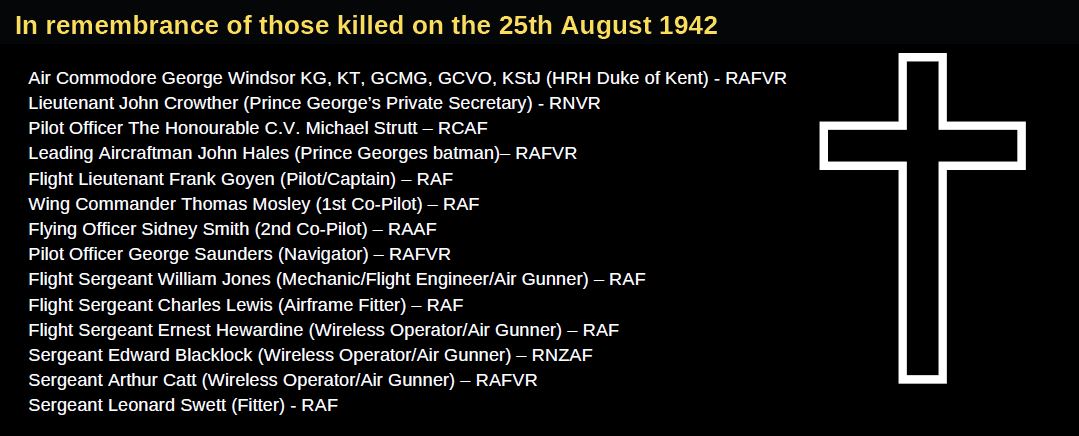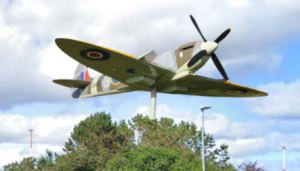Site 25. HRH Duke of Kent
At 13:10 on the 25th of August 1942, Short Sunderland DQ-M (W4026) of 228 Squadron, piloted by Flight Lieutenant Frank Goyen, took off from RAF Invergordon destined for Iceland. Onboard the aircraft were the other 10 crew members plus 4 passengers, one of whom was HRH Prince George, Duke of Kent, the Younger Brother to King George VI. The Duke held the Honorary rank of Air Commodore and was making an official visit to RAF Reykjavik in the course of his duties as a Staff Officer in the Welfare Section of the RAF Inspector General’s Staff.

The aircraft had started its flight earlier that morning from RAF Oban but made a stop at RAF Invergordon to pick up Prince George. The flight plan required the pilot to follow a course parallel to the coast until it reached Duncansby Head where it would turn northwest towards Iceland. At just before 14:00 hours the aircraft flew into the ground at Eagle’s Rock (Creag nah-lolaire) near Dunbeath exploding on impact. The resulting fireball from the fuel in the freshly topped up fuel tanks engulfed the aircraft instantaneously killing all on board, with the exception of the rear gunner Flight Sergeant Andrew Jack.
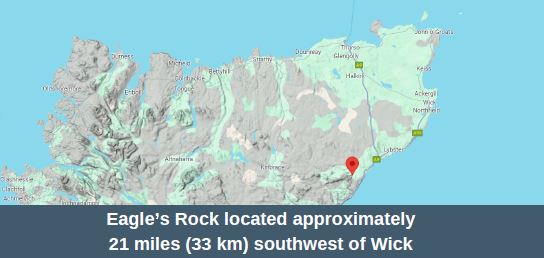
It is unclear why the aircraft turned inland when it did or why it had descended to 700ft by the time it struck the ground at Eagle’s Rock. The court of inquiry concluded that the plane crashed into the hillside due to an error of navigation, i.e. there was not enough allowance made for wind, which caused the aircraft to drift off its planned track. The Board noted that an investigation at the crash site suggested that all four engines were at full power at the time of impact.
The board placed the blame for the accident entirely on the pilot, stating: “The responsibility for this serious mistake in airmanship lies with the Captain of the aircraft Flight Lieutenant Goyen, who changed his flight plan for reasons unknown, was such that he commenced the flight by climbing into cloud and then started to descend but failed to take the elementary reaction of making sure that he was over the water and crashed into a hillside while still in cloud. In our opinion the weather encountered should have presented no difficulties to an experienced pilot.”
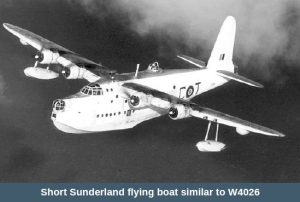
However, a number of issues remain unsolved. All the crew were hand-picked, highly experienced aviators, and why had the aircraft flown off course so early in the flight over known hilly terrain in poor visibility? A lack of official documentation “much of which went missing” together with access to the Royal Archives being denied has, over the ensuing years fuelled speculation and conspiracy theories.
When the aircraft crashed the rear gun turret broke off, avoiding being completely engulfed in the flames. This explains how Flight Sergeant Jack survived, although he was badly injured. Confused, disorientated, and suffering from burns to his hands and face he wandered aimlessly in the mist until he was discovered by the Sutherland family at their remote croft at Rinsary the following day. ‘Jack’ claimed to have crossed many bridges whilst lost, but there were only 4 footbridges in the area so the family concluded that he must have been going in circles.
It is known that whilst at the Bignold Hospital in Wick ‘Jack’ was visited by two senior RAF Officers, and some believe he was reminded of the consequences of breaking the Official Secrets Act. He remained in the RAF until 1964, finally dying in 1978 aged 56 but always refused to answer any questions regarding the incident. It has however been claimed by his daughter that he told his brother that Prince George was actually flying the aircraft at the time of the accident and that he had dragged the prince’s body from the pilot’s seat after the crash. He was also said to have claimed that there was another person on board, but this has never been confirmed.
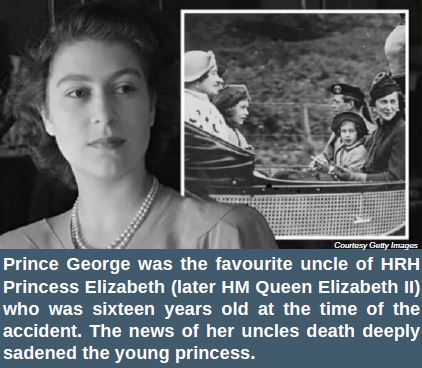
There is also a theory that enemy infiltrators tampered with the flight before it took off from Invergordon, planting an explosive device in some luggage. Another theory speculates that atop secret report was received by the Nazi Foreign Minister, Joachim von Ribbentrop, on the 5th December 1942 claiming that the Duke of Kent was apparently sympathetic to a peaceful understanding with Germany and an internal British sabotage plot had been carried out to avoid a potentially embarrassing problem for Britain.
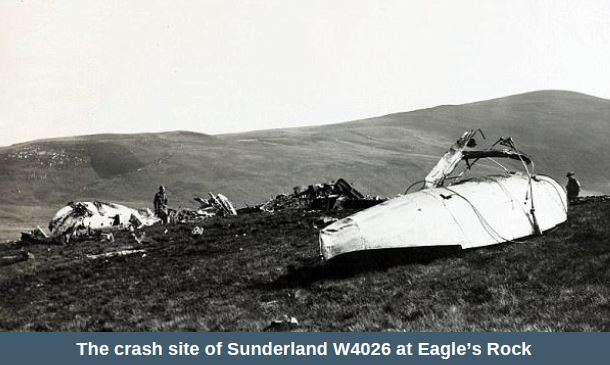
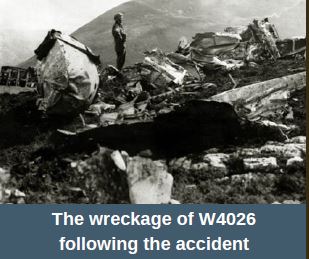
It is known that pilots would quite often fly a shortcut to Iceland by cutting across the north of Scotland rather than continuing on the longer flight path to Duncansby Head. It is also known that Flight Sergeant Jack’s daughter claimed that friends of the duke were staying at Langwell House at Berriedale, which is very close to the crash site and, when coupled with the last know message from the flight deck, “Let’s go down and have a look…”, a more plausible explanation is that this was simply a terrible accident caused, possibly, by the pilot indulging the whim of the royal personage, resulting in the aircraft hitting high ground in poor visibility conditions. Listening to the intercom at the rear of the aircraft Flight Sergeant Jack would have known exactly what was taking place, but with all the records relating to the crash either missing or still sealed, it is likely that we will never really know the real truth about what happened.
 Prince George was the first member of the British Royal Family to die on active military service since the death of James IV of Scotland at the Battle of Flodden in 1513, and members of the royal family still visit the crash site at Eagle’s Rock from time to time, King George VI made his own special pilgrimage to the site not long after the crash. The crash site is marked with a memorial in the form of a Celtic cross, with a 2nd marker to the north marking the spot where the Duke’s body was discovered.
Prince George was the first member of the British Royal Family to die on active military service since the death of James IV of Scotland at the Battle of Flodden in 1513, and members of the royal family still visit the crash site at Eagle’s Rock from time to time, King George VI made his own special pilgrimage to the site not long after the crash. The crash site is marked with a memorial in the form of a Celtic cross, with a 2nd marker to the north marking the spot where the Duke’s body was discovered.

